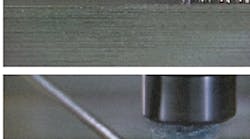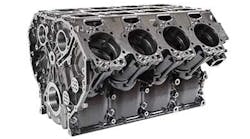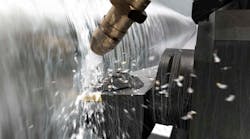A new PVD coating technology for dry machining protects cutting edges from wear while simultaneously ensuring reliable chip evacuation.
Chips flow through the flute of the Balinit HARDLUBE coated drill as if the drill was lubricated. After drilling the same number of holes, the TiALN coated drill must be replaced.
Surface quality after the same number of drilled holes: TiAlN (left) and Balinit HARDLUBE (right).
This figure shows the SEM cross-section of the new Balinit HARDLUBE coating structure.
Dry machining is one of the industry's hottest topics. Both economical and environmental factors contribute to the recent increase in mist and dry machining. Manufacturers are looking for ways to reduce costs and, at the same time, avoid the environ-mental hazards associated with the use and disposal of large amounts of industrial coolants and lubricants.
However, eliminating coolants and lubricants from the machining process is easier said than done, considering the crucial advantages they provide. Metalworking fluids reduce friction in the tool-workpiece contact zone (lubri-cation effect), remove the chips from the cutting area (flushing effect), transport thermal energy dissipated in the contact zone (coolant effect), and have a cleaning and anticorrosive benefit. Thus, manufacturers face a serious dilemma when they weigh these considerable advantages against the enormous costs involved with using, maintaining, and disposing of metalworking fluids.
But a new coating called Balinit HARDLUBE combines a hard and soft coating and provides effective chip evacuation without conventional lubrication. The hard layer is a titanium aluminum nitride (TiAlN) coating, while the soft, lubricant layer is tungsten carbide/carbon (WC/C), a coating of medium hardness and low coefficient of friction. The combination of these coating layers results in improved chip flow while generating a lower coefficient of friction and reduced cutting force.
Balinit HARDLUBE is produced by two PVD technologies in a single coating operation. The TiAlN layer is produced by enhanced arc, while the top layer of WC/C is deposited by sputtering.
The TiAlN hard layer of HARDLUBE protects severely loaded edges against wear at extreme temperatures. TiAlN coatings are mainly deposited through evaporation of TiAl target material using the reactive gas nitrogen.
The sliding and lubricating properties of the outer WC/C coating eliminate initial cut run-in effects, uniformly control chip formation, and reduce friction of outgoing chips. In dry sliding tests (pinon-desk) WC/C coatings exhibit very low values of wear on both the coated surface and the uncoated counterface over extended periods of time. Typically the microhardness of WC/C coating is approximately 1,000 (HV 0.05).
Drilling and tapping applications
Premature tool replacement or expensive waste because of tool failure are common problems in dry drilling and tapping of long-chipping materials. Extreme temperatures that develop at the cutting edges are the main source for such problems because the tool becomes more susceptible to wear and fracture. Deformed hot chips, which may weld to the tool and form built-up edges, also greatly impair reliability. The chip jamming that results quickly brings a premature end to tool life.
The Balinit HARDLUBE coating addresses these problems by combining the advantages of an extremely hard, thermally stable TiAlN coating with the sliding and lubricating properties of an outer WC/C coating.
To substantiate its effectiveness, a demanding dry drilling test was conducted. Test tools drilled deep blind holes (drill depth being four times drill diameter) in alloy steel to differentiate the performance of the new coating versus uncoated and TiAlN-coated standards. The uncoated drill broke almost immediately after one hole, the TiAlN-coated drill produced 85 holes, and the Balinit HARDLUBE-coated drill delivered 108 holes. With the specially coated tool, tool productivity increased without the need for expensive, environmentally hazardous lubricants.
Balinit HARDLUBE-coated HSS and solid-carbide drills deliver good results in cutting problematic, long-chipping materials (soft steels, stainless steels, and aluminum alloys), dry or with minimal coolant. Dry drilling of steel is now possible even with small diameter drills, where internal coolant holes and flute polishing are not possible.
The coated tools can also be used in punching, forming, and molding applications. They work well on aluminum, copper, stainless steels, plastics, rubber, and adhesive materials.
The advantages that exist when using these coated tools are significant. For example, longer tool life means shorter replacement schedules, and improved chip flow prevents jamming. Hole quality is better, and there is no costly post-treatment such as polishing or blasting of coated flutes. The tools are also a good solution for small diameter drills. And with high reliability in both wet drilling and tapping, coupled with the option to switch these operations from a wet center to dry cutting in transfer lines, the tools offer many benefits to manufacturers looking for better dry machining operations.
Balinit HARDLUBE specifications | |
| Coating material: | Monolayer TiAlN plus WC/C |
| Microhardness (HV 0.05): | TiAlN approx. 2,600; WC/C approx. 1,000 |
| Coating thickness: | 2 up to 6 µm ( 1 /3 WC/C, 2 /3 TiAlN) |
| Color: | black-gray |
| Coefficient of friction against steel (dry): | 0.2 |
| Maximum service temperature in air: | 800 up to 1,000°C (1,472°F to 1,832 °F) |
The properties of Balinit HARDLUBE are shown above and compared to a number of other commercially available coatings below.
Property comparison of PVD coatings
(HV 0.05)










